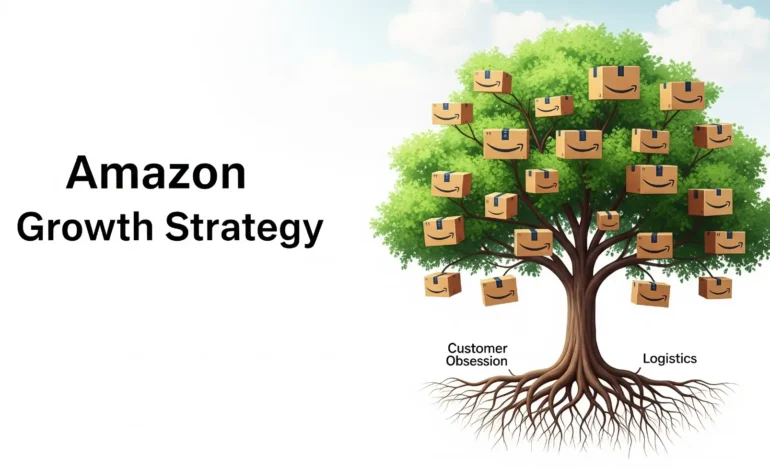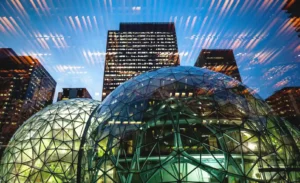The Amazon Growth Strategy Blueprint: 5 Core Pillars of a Tech Empire

In a Seattle garage in 1994, a company was born with a simple goal: to sell books online. Today, that company, Amazon, is a colossal empire that has fundamentally reshaped global commerce, cloud computing, and artificial intelligence. Its journey is one of the most studied stories in modern business.
This transformation was not a series of fortunate accidents. It was the result of a deliberate, often misunderstood, and relentlessly executed plan. While competitors focused on short-term profits, Amazon was quietly building a blueprint for long-term domination. To understand the company is to understand the Amazon Growth Strategy.
Many have tried to replicate its success, but few grasp the underlying principles that act as the company’s operating system. This blueprint isn’t just about selling things online; it’s a systematic approach to building a durable and ever-expanding enterprise. Here, we break down the 5 core pillars of the Amazon Growth Strategy that built a tech empire.

Pillar 1: Obsess Over the Customer, Not the Competition
The foundational pillar of Amazon is its “Day 1” philosophy of customer obsession. While most companies are competitor-focused, Amazon is customer-focused. This customer-first mindset is the starting point for the entire Amazon Growth Strategy. Jeff Bezos famously articulated this by leaving an empty chair in early meetings, stating it belonged to the customer, “the most important person in the room.”
This obsession manifests in tangible ways that built deep, lasting trust:
- Embracing Negative Reviews: In the early days, publishers were horrified that Amazon allowed negative customer reviews, arguing it would hurt sales. Bezos’s counter-argument was simple: “We don’t make money when we sell things. We make money when we help customers make purchase decisions.” This decision to prioritize honest information built immense credibility.
- Reducing Friction: Features like the patented 1-Click ordering system and a hassle-free returns policy were designed to remove every possible point of friction. This relentless focus on convenience created a shopping experience that was simply easier than anywhere else.
Pillar 2: Build the Flywheel and Let It Spin
The engine behind Amazon’s e-commerce dominance is a concept called the “Flywheel Effect,” which Bezos adopted from business researcher Jim Collins. It’s a self-reinforcing loop where each component drives the next, creating unstoppable momentum. The core of this Amazon Growth Strategy is elegantly simple but incredibly powerful.
It begins with the customer experience. By lowering prices, Amazon attracts more customers. This high volume of traffic makes Amazon an incredibly attractive platform for third-party sellers, who rush to list their goods. This flood of third-party sellers dramatically increases product selection. This combination of vast selection and low prices leads to a world-class customer experience, which in turn drives even more traffic. As detailed in Collins’s work on his official website, this growth allows Amazon to operate at a massive scale, which lowers its cost structure and enables it to invest in better logistics and lower prices further.

The loop looks like this:
- Lower Prices lead to a…
- Better Customer Experience, which drives…
- More Traffic, which attracts…
- More Sellers, which leads to…
- Greater Selection, which improves the…
- Customer Experience, and allows for a…
- Lower Cost Structure, which enables… Lower Prices.
Pillar 3: Play the Long Game: A Culture of Patience
For years, Amazon was famous for its lack of profits, baffling Wall Street analysts. This was a core feature of the Amazon Growth Strategy: prioritize long-term market leadership over short-term profitability. In his now-famous 1997 Letter to Shareholders, Bezos laid out this philosophy plainly, stating they would always make decisions in light of long-term considerations.
This meant reinvesting every dollar back into the business to strengthen the flywheel—building more fulfillment centers, investing in technology, and lowering prices. This focus on the future is a key differentiator in the Amazon Growth Strategy. It allowed the company to plant “seeds” that would take years, or even decades, to grow into significant businesses, like the Kindle ecosystem and, most importantly, Amazon Web Services.
Pillar 4: A Culture of Invention (and Failure)
A pivotal pillar of the Amazon Growth Strategy is its incredible ability to turn its biggest internal costs into wildly profitable global services. The greatest example of this is Amazon Web Services (AWS).
In the early 2000s, Amazon’s engineers had become world-class experts at managing massive, scalable, and reliable computing infrastructure to run their complex e-commerce site. They realized this internal capability was a product in itself. In 2006, they launched AWS, renting out their data storage (S3) and computing power (EC2) to developers. It completely revolutionized the tech industry, allowing anyone to access the same computing power as a major corporation. Today, AWS is Amazon’s most profitable division.
This culture of invention requires an acceptance of failure. The disastrous Fire Phone in 2014 resulted in a write-off of over $170 million. At another company, this might have ended all hardware ambitions. At Amazon, the lessons learned were directly applied to the development of a new device category: the Amazon Echo, powered by Alexa.

Pillar 5: Operational Excellence
While AWS conquered the digital cloud, Amazon was simultaneously building an unprecedented empire on the ground. The company understood that an online promise is only as good as its physical delivery. Mastering logistics became the physical manifestation of the Amazon Growth Strategy.
This pillar involved two key moves:
- Warehouse Revolution: In 2012, Amazon acquired Kiva Systems, a robotics company, and transformed its fulfillment centers. Instead of workers walking miles of aisles, fleets of robots now bring the shelves directly to them, dramatically increasing efficiency.
- Building a Delivery Network: To control the entire customer experience, Amazon began building its own logistics network. From Amazon Air cargo planes to a fleet of branded delivery vans, they systematically reduced their reliance on third-party carriers like UPS and FedEx.
This logistics network is Amazon’s physical moat—a massive, capital-intensive advantage that is nearly impossible for competitors to replicate.
Conclusion
The Amazon Growth Strategy is not a single tactic but a powerful, interconnected system. Customer obsession provides the energy for a self-perpetuating flywheel. This growth is funded by a patient, long-term vision and the profits from inventive side-bets like AWS, all while being supported by a world-class logistics network. Understanding the Amazon Growth Strategy provides a masterclass in modern business. It is this combination of principles, relentlessly applied over decades, that transformed a small online bookstore into a true tech empire.
For more deep dives into the strategies behind the world’s biggest tech companies, explore the analyses and reports at techpastel.com.




